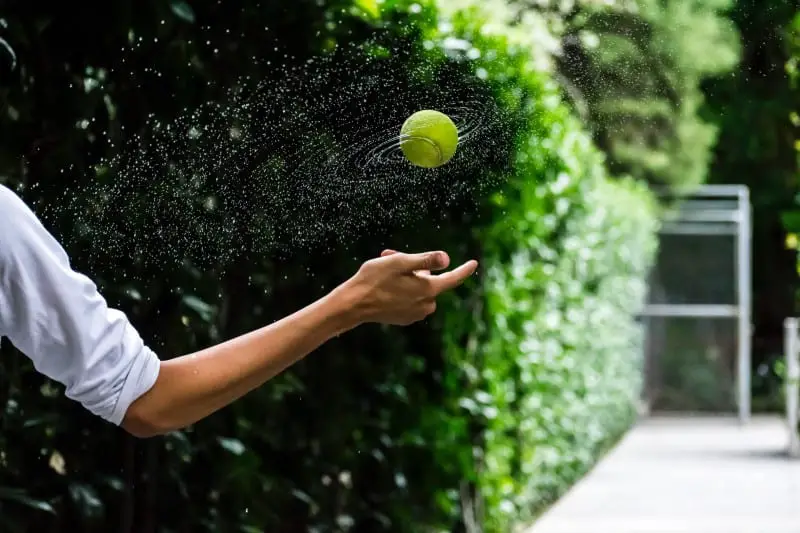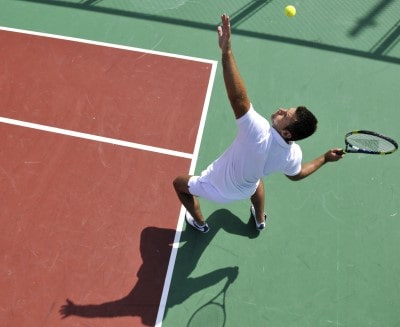When it comes to practicing at home, few sports are as difficult to work with as tennis. Tennis notoriously requires a court to play–one that can’t be replicated in a typical driveway. Unfortunately, many country clubs are just too expensive to regularly practice at. So, what’s a player to do?
How do you practice tennis at home alone? Believe it or not, there are several different options homebody tennis players can choose from when it comes to solo play. These include:
- Buying Home Practice Tools
- Practice Shadow Swinging
- Play Against A Wall
- Play “Bounceless Catch” With Your Ball
- Practice Your Ball Toss
Each method of practice will help you improve your game while you’re on the court, but there’s a caveat. Each practice option will only sharpen on or two skills you’ll need for tennis. This guide will help you understand what you can do.

How Do You Practice Tennis At Home Alone?
Being a solo player stuck without a tennis court can be pretty terrible but that doesn’t mean you don’t have options. It’s all about maximizing the assets that you have around your home and knowing when to place some limits.
Before we begin delving into the different exercises you can use, it’s a good idea to start thinking about different factors that can change your practice outcomes. When figuring out your tennis practice routine at home, keep in mind these helpful tips:
- Watch your budget. There are currently several different gizmos online that allow you to practice tennis at home solo. They can be fairly pricey but can also be a couple-dozen dollars.
- Remember your home’s shortcomings. If you have paper-thin walls, bouncing your tennis ball off them indoors won’t be a good idea.
- Avoid practicing near windows. It’s just not a good idea.
- It’s usually best to practice outside or in the basement. Regular walls will be a little too fragile and noisy for most people who want to do indoor practice.
Buying Home Practice Tools
To start off your home tennis practice routine, let’s talk about home tennis practice tools. The sports industry started to notice the need to pratice a swing and developed devices to make it possible to do at home. Here’s a run-through of the most popular options…
TopspinPro Tennis Aids
If you need to brush up on your topspin (and who doesn’t?), getting a training aid like the TopSpinPro might be your best bet. This gives players a way to practice their topspin indoors using a ball suspended in air with a wire.
Tennis Rebounders
Rebounders are bouncy nets that “toss a tennis ball back to the server. As one of the more common home practice tools on the market, this option gives you a more realistic play and also helps you work out multiple issues. A good tennis rebounder is always a wise choice!
Rebound Trainers
Rebound trainers are not the same as rebounders. Trainers are small, weighted tools that allow you to pick up and serve the ball. The ball is tied to the weight, which then keeps the ball rebounding to you. Trainers are generally seen as a more affordable way to practice a serve.
Do You Have To Buy Practice Tools?
While they do offer a lot of benefits to the avid player, you never really need to get tennis practice equipment in order to up your game. In most cases, training tools just offer a way to improve one or two elements of your gaming ability at best.
When Doesn’t It Make Sense To Buy Tennis Aids?
Budgeting aside, there’s one main reason why it sometimes just doesn’t make any sense to get a tennis practice aid for your solo session. The vast majority of tennis practice aids are only really usable outdoors, with some even requiring a rather large distance to work best.
If you have an apartment building or just don’t have a large yard, it may not be sensible to try to get tennis practice aids for your solo training. After all, why would you buy something that you can’t really use?
Practice Shadow Swinging
Most people have heard of “shadow boxing,” but have you ever heard of shadow swinging? This is a tennis practice move that mimics the boxing training method. To do this, use the following steps below:
- Stand in front of a mirror. Don’t worry, you won’t actually hit balls towards it.
- Practice your groundstrokes. It’s best to alternate between forehand and backhand strokes and to start off slowly.
- While you’re practicing your swings, keep an eye on important aspects of your technique. The mirror can help you notice things you otherwise would have missed, such as foot placement, grip, and your turning technique.
Why Does Shadow Swinging Work?
Shadow swinging is a highly effective practice method because it forces you to be more aware of the subtle movements your body makes during a game. That mindfulness translates into regularly correcting issues and improving your awareness of your moves on the court.
Another way to explain it? Well, you can’t correct what you don’t know is wrong. By literally holding up a mirror to yourself as you practice your swing, you make it impossible to actually ignore the technical issues you have. This makes it easier to figure out how to better your swing and take the steps to improve your game.
Play Against A Wall
If you’ve ever played racquetball, then you already know how useful having a brick wall can be for improving your tennis game. This classic technique lets you improve your serve, feel out the angles that your hits give, and also get a fairly decent workout.
Of course, there are limitations to how often you can do this. If you don’t have a brick wall or if your house has one too many windows, using this method might be more of a liability than it’s worth.
Play “Bounceless Catch”
During the wintertime, it’s a lot harder to go into your backyard to practice your game. That’s why it’s a good idea to have a couple of indoor-friendly options you can try out. Bounceless Catch is one of the easiest ways to improve your tennis skills indoors.
This practice technique is meant to help you get a better eye for the ball and improve your ability to finesse the ball around. Here’s how to play this classic training game:
- Grab your racket and your ball. You will need both in order to play this game.
- Toss your ball up into the air. You don’t always have to toss it high, but it can help.
- Try to “catch” the ball using your racket with as little bounce as possible. Your racket’s strings should act as a safety net. To help reduce bounce, lower the racket at about the same velocity as the ball’s drop.
Practice Your Ball Toss
Each practice method that you can do at home has a tendency to zero in on one aspect of your swing or your serve. This training technique isn’t any different. Practicing your ball toss can have some serious impact on your ability to serve properly and gain an advantage in the game.
Practicing your ball toss is simple: just toss the ball in the air as if it was a serve toss. With this drill, it’s important to remember that the ball toss is one of the most easy-to-control factors in your game. Keeping an eye on your technique can work wonders.


